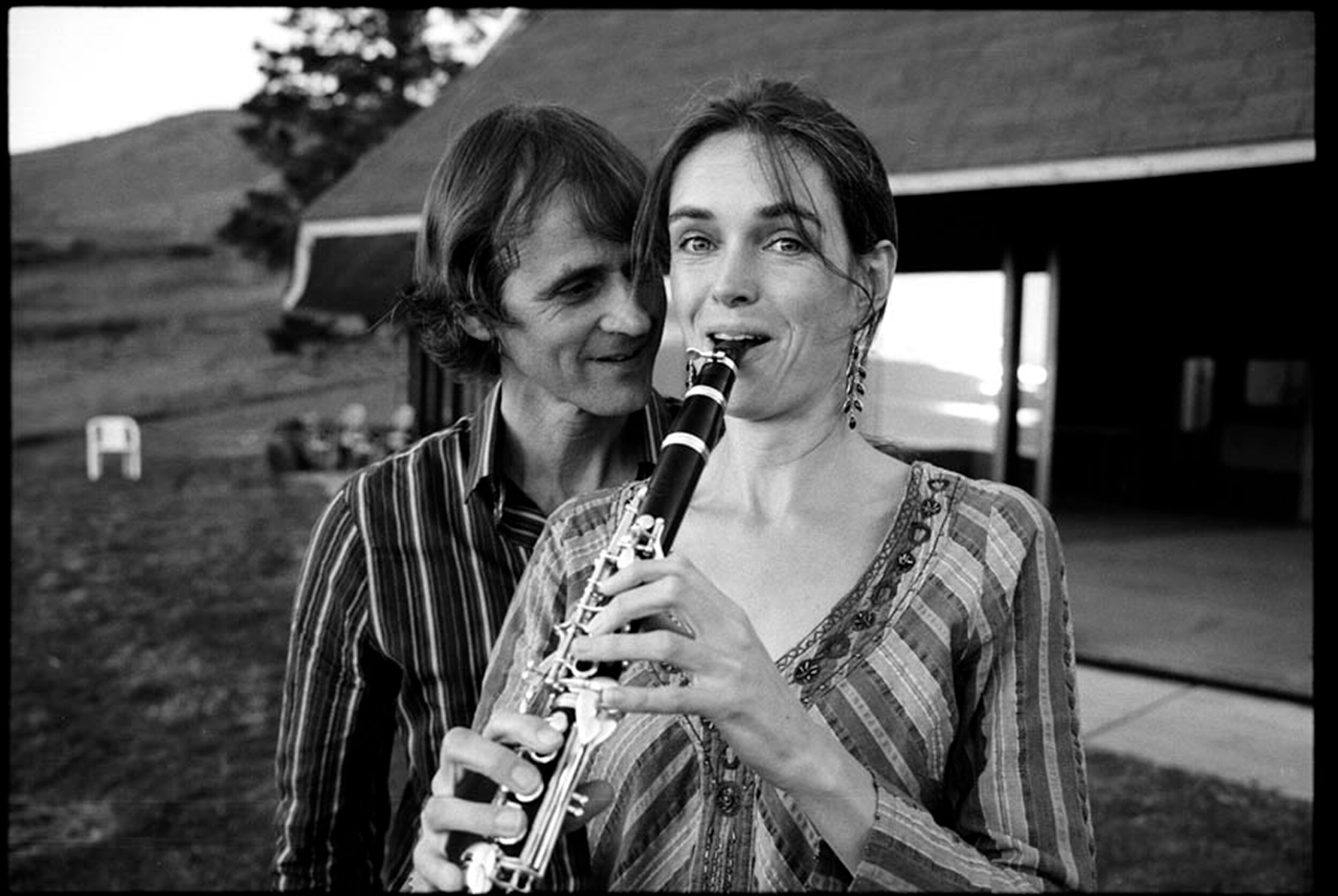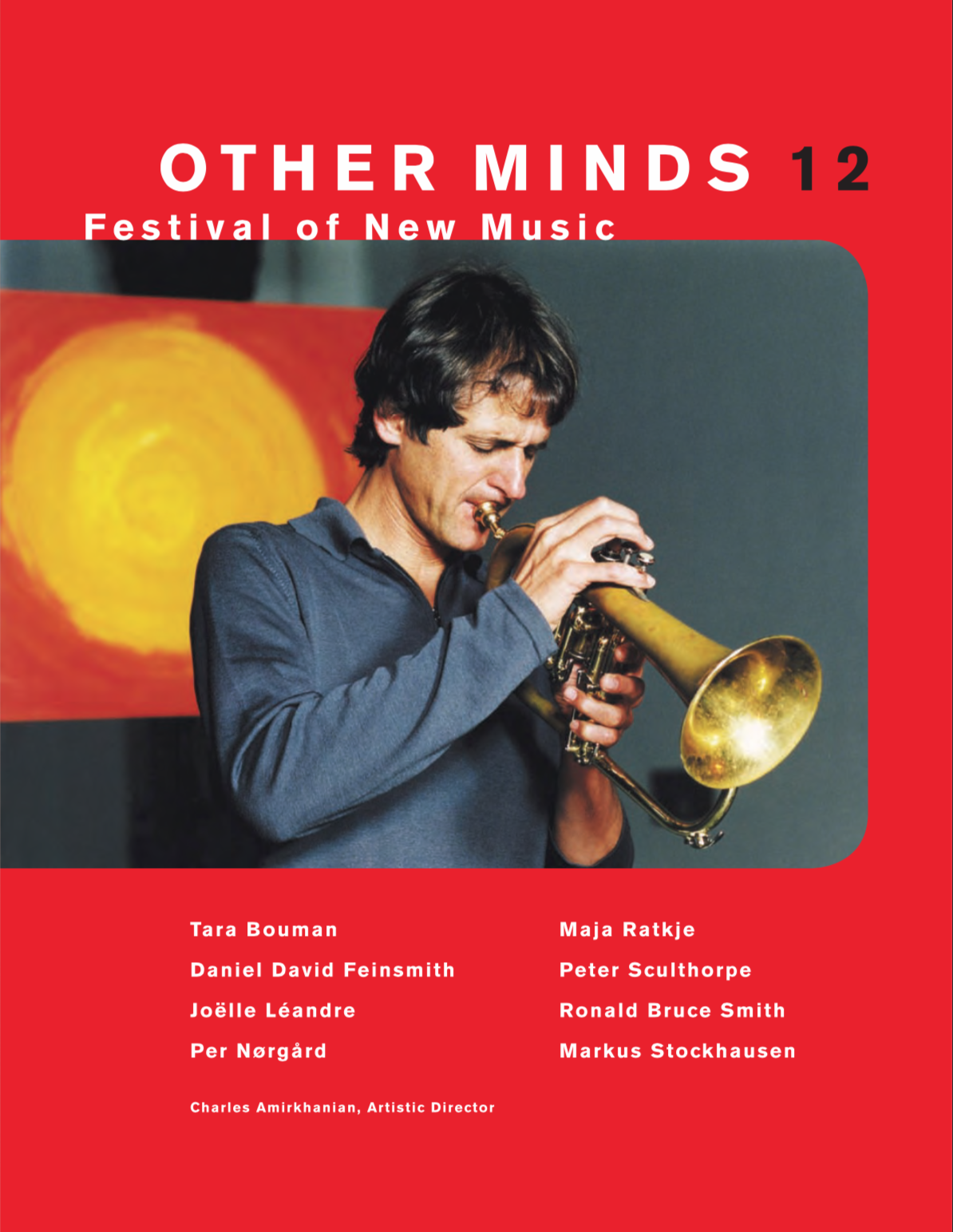
Statement by Other Minds Executive and Artistic Director, Charles Amirkhanian
A gathering of so many composers and performers at an Other Minds Festival is a special occasion, both for artists and audiences. It brings together the collective experience of such composers as Per Nørgård and Peter Sculthorpe, representing over 100 years of composing, and, when we add up that of the other guest composers, performers and our most dedicated concert-going audience members, literally thousands of years of new music mindfulness that animates this community for a special weekend in San Francisco.
For the week prior to the festival, our guest composers from nine countries met in private conference at the lovely site of the Djerassi Resident Artists Program in Woodside, forty miles south of San Francisco, to share their work and their life journeys in a way composers rarely are able to do. It is one goal of the Other Minds Festival to promote connections within our often-fragmented legion of practitioners with the hope that each composer will come away recharged and invigorated. Invariably, our composers have told us that they truly appreciate this short but intense period of the time together and often make lifelong friendships that become a lasting reminder of their visit to the Bay Area.
This year for the first time we including teenage composers-a group from Vacaville Christian High School-who performed their own Electrical Resonance Symphony on a Tesla coil, theremin and other instruments at the intermission of our closing concert. Experimentation in music, far from being a dying practice, has grown exponentially thanks to the advent of the personal computer. A grass roots movement of youth in unprecedented numbers is exploring the world of sound and music (and discovering their antecedents on our internet website as well!).
Charles Amirkhanian, Artistic Director
Artist Bios
At an early age, Daniel David Feinsmith (b. NYC) was steeped in classical music through his parents and grandfather, who were members of leading orchestras including the New York Philharmonic, Israel Philharmonic and Denver Symphony Orchestra. His father Marvin Feinsmith has composed numerous solo, chamber, and symphonic works, and is one of a multigenerational line of composers, musical performers and writers which has been traced in an unbroken line as far back as the 1600s, including his grand uncle Leonid Andreyev, the greatest writer of the Russian Revolution.
Feinsmith studied western composition under Terry Riley, John Corigliano, John Thow and Edmund Campion. He also studied North Indian Classical Music under Ali Akhbar Khan, Terry Riley, Shabda Kahn, Pandit Jagdish Mohan, Sri Karunamayi, Ustad Mashkur, Ali Khan and others, in the US and numerous visits to Asia. Feinsmith composes works for concert soloists and ensembles, and has received commissions and awards from The Kronos Quartet, The American Brass Quintet, The Alexander String Quartet, Grammy Nominee Solo Pianist David Holzman, Yaddo Artists Residency, Djerassi Residency Program, Filmmaker Rob Nilsson, Pacific Film Archive, Berkeley Civic Arts Commission, the Jess Shensen Music Fund of Congregation Emanu-El, The Sifriya Foundation, ASCAP, the American Composers Forum and others. He works and teaches in Emeryville, California.
Per Nørgård (b. 1932) is Denmark’s leading contemporary composer. In his youth a traditionalist from the mold of Carl Nielsen and Jean Sibelius, he has explored many compositional techniques throughout his career. His early teacher, Vagn Holmboe, piqued Nørgård’s interest in organic music development and the concept of metamorphosis—using small motifs that are developed polyphonically. In the 1960s, Nørgård experimented with collage and interference techniques and electronic music. Simultaneously, Nørgård developed his own serial procedure, the infinity series, that generates melodies fractally and endlessly in multi-layered polyphony reminiscent of the Renaissance prolation canon. In the 1980s, Nørgård adopted a more dramatic, spontaneous style, prompted by his viewing of an exhibition entitled “Outsiders” that presented works by mentally ill artists including those of the schizophrenic Swiss artist Adolph Wölfli (1864-1930). This encounter prompted the composition of many of Nørgård’s most popular works, including Wie ein Kind, the first of many Wölfli-inspired works. Even in his Wölfli period, Nørgård did not completely abandon his earlier compositional techniques. In subsequent work and today, Nørgård melds his techniques into new forms. “I find myself on a succession of different slippery slopes, but always on slippery slopes. Yet this isn’t a matter of escaping, for usually earlier strategies and ideas emerge again later—in new contexts.”
Peter Sculthorpe is an original voice in Australian music, combining an eclectic and constantly-evolving style rooted in classic forms with an intense interest in the indigenous music of his native land and the Pacific Rim. His determination to document in sound the socio-environmental character of Australia has made Sculthorpe the country’s best-known composer and “the voice of the nation.” Born in Launceston, Tasmania in 1929, Sculthorpe was educated at Launceston Church Grammar School, the University of Melbourne, and Wadham College, Oxford. He was composer-in-residence at Yale University while visiting the United States as a Harkness Fellow in 1966-67, and Visiting Professor at the University of Sussex in 1972-73. Appointed Reader in Music at the University of Sydney in the late Sixties, he is now Professor in Musical Composition (Personal Chair) at that university. Sculthorpe has earned appointments as an Officer of the British Empire, Officer of the Order of Australia, Fellow of the Australian Academy of the Humanities, and Lifetime Member of the American Academy of Arts and Letters. In addition, he has been the recipient of many awards and prizes for his works, including Honorary Doctor of Letters degrees from the Universities of Tasmania and Sussex, the Honorary Doctor of Music degree from the University of Melbourne, a Silver Jubilee Medal, the Sir Bernard Heinze Award for outstanding services to Australian music, an Australian Film Industry Award for best original film score (Manganinnie), and the 1985 APRA Award for most performed Australian serious work (Piano Concerto).
Ronald Bruce Smith is a Canadian composer whose works incorporate both acoustic instruments and electronics. Many of Smith’s works share a contemplative character, a preoccupation with enhancing the resonance of a given ensemble and an openness to new sound sources (including non-Western ones). His Kyrie Eleison, intended as a memorial for the fourteen students murdered at the University of Montreal in December 1989, combines a soprano soloist, orchestra and live electronics in a “quiet plea for mercy as well as a static prayer for spiritual reflection.” In Meditations, based on research begun at IRCAM and realized at Berkeley’s Center for New Music and Audio Technologies (CNMAT), Smith manipulates materials drawn from Pakistani vocal music and the Indonesian gamelan (percussion orchestra).
In works like Remembrances of a Garden for chamber ensemble, timbral variety comes from dramatic articulations and subtle performance techniques. In his chamber work Flux, timbral variety results from a mathematical exploration of tone color based on the imaginative manipulation of harmonic spectra from the overtone series. Smith studied composition at the University of Toronto, McGill University, and the University of California at Berkeley from which he received the Ph.D. in music. His principal composition teachers include Tristan Murail, Bruce Mather, Richard Felciano, and Talivaldis Kenins, and he has studied computer music and synthesis with David Wessel. Smith has taught at the University of Illinois at Champaign-Urbana, the University of California at Berkeley, and Stanford University; he is currently on faculty at Northeastern University in Boston.
French double bass player, improviser and composer Joëlle Léandre is one of the dominant figures in new European music. Trained in orchestral as well as contemporary music, she has played with Itinéraire, 2E2M and Pierre Boulez’s Ensemble Intercontemporain. Joëlle Léandre has also worked with Merce Cunningham and with John Cage, who composed especially for her, as have Scelsi, Fénelon, Jolas and Clémenti. As well as working in contemporary music, Léandre has played with some of the great names in jazz and improvisation, such as Derek Bailey, Anthony Braxton, Georges Lewis, Evan Parker, Irène Schweizer, Steve Lacy, Fred Frith, and John Zorn. She has written extensively for dance and theatre, and has staged a number of multidisciplinary performances. Her reputation is international, and her work as a composer and a performer, both in solo recitals and as part of ensembles, has put her under the lights of the most prestigious stages of Europe, the Americas and Asia. Joëlle Léandre also has more than a hundred recordings to her credit.
Frode Haltli (b. 1975, Norway) began playing the accordion at the age of seven. As a child he played folk music but soon moved into different forms. Playing music by composers such as Pietr Fiala, Per Nørgård, Arne Nordheim as well as classical music, he swiftly developed exceptional instrumental skills alongside a deep understanding of new music. In his early years he won numerous national contests, raising interest in and appreciation of the accordion to unprecedented heights. Haltli studied at the Norwegian State Academy of Music, then at the Royal Danish Music Conservatory in Copenhagen, graduating in 2000. In 2001 the Norwegian Concert Institute named him Young Soloist Of The Year, he was also placed second in the International Gaudeamus Interpreters Competition 1999 in the Netherlands.
Since 1999 he has played regularly with the trio POING, alongside saxophonist Rolf-Erik Nystrøm and double bass player Håkon Thelin. They have commissioned close to a 100 works from composers all over the world and recorded several albums.
Born December 29th, 1973 in Trondheim, Norway, Maja Solveig Kjelstrup Ratkje finished composition studies at the Norwegian State Academy of Music in Oslo in 2000. Her music has been heard all over Europe as well as in Japan, China, Canada, USA and Eastern Russia. Her composed works have been performed by Oslo Sinfonietta, The Norwegian Radio Orchestra, Arve Tellefsen, Cikada and Vertavo string quartets, Quatuor Renoir, Ticom, crash Ensemble, Torben Snekkestad, SPUNK, Frode Haltli and POING among others. Ratkje has received many awards and commissions such as the International Rostrum of Composers in Paris for composers below 30 years of age, the Norwegian Edvard Prize (work of the year) twice, second prize at the Russolo Foundation, and in 2001 she was the first composer ever to receive the Arne Nordheim prize. Her solo album Voice, made in collaboration with Jazzkammer, earned a Distinction Award at Prix Ars Electronica in 2003. Ratkje is active as a vocalist and electronics player as well as studio engineer, mainly in connection with the contemporary improvisation ensemble SPUNK and the noise duo Fe-mail, which together with dancer Lotta Melin forms the performance trio Agrare. Other main collaborators are Jazzkamer, POING, The Icelandic Dance Company, Odd Johan Fritzøe, Øyvind Berg and Jaap Blonk. Ratkje has performed her own music for films, dance and theatre performances, installations, and numerous other projects including her own opera in 2003 and her Concerto for Voice in 2005.
Trumpeter and composer Markus Stockhausen is one of the most versatile musicians of our time. He studied initially at the Cologne Musikhochschule and is as much at home in jazz as in contemporary and classical music. For about 25 years he collaborated closely with his father, the composer Karlheinz Stockhausen, who wrote many works for him. As soloist, improviser, and composer Markus Stockhausen is in international demand. He has played in and led various jazz ensembles and plays contemporary and intuitive music in the duo Moving Sounds with clarinetist Tara Bouman, as well as with the percussionist Mark Nauseef and others. He has realised several major music projects in close collaboration with his brother Simon and also regularly creates projects in different environments, bringing together guest musicians from different cultures, like Arild Andersen on bass, Dhafer Youssef voice and oud, Angelo Comisso on piano and Ferenc Snétberger on guitar. Works recently dedicated to him include Peter Eötvös’ trumpet concerto Jet Stream and his own recent compositions include Portrait for Tara for basset horn and ensemble premiered in 2004 by Tara Bouman and the London Sinfonietta and Any Way composed for the Festival Players at the 2005 Cheltenham Music Festival. He also composes for film. Stockhausen has released more than 50 CDs to date.
The Dutch clarinetist Tara Bouman studied with Piet Honingh and was a student of Suzanne Stephens. As a soloist and chamber musician she has performed in many international venues—throughout Europe, in Mexico and in the United States. She started her career playing mainly contemporary music, which then took her to the field of improvisation, where her main focus lies now. Tara Bouman founded with Markus Stockhausen the duo Moving Sounds. She plays regularly with percussionist Stephan Froleyks and performs in duo with storyteller Regina Sommer. Other musical partners are: pianist Fabrizio Ottaviucci, double bass player Stefano Scodanibbio, and percussionist Mark Nauseef. As a soloist she has worked with composers such as Isabel Mundry, Karlheinz Stockhausen, György Kurtag, and Roderik de Man. In cooperation with DeutschlandRadio the Cologne Label Aktivraum published in 2003 her first CD with new music: Contemporary. In 2004 the CD Thinking About followed, played by Moving Sounds.
Festival Program
Friday, December 8, 2006
8:00 pm Concert, Kanbar Hall, JCCSF
Peter Sculthorpe:
From Saibai (1997)
Stenberg-Zimmermann Duo
Kate Stenberg, violin; Eva-Maria Zimmermann, piano
Per Nørgård:
Quartet No. 10 for Strings, “Høsttidløs” (Harvest-Timeless)
Del Sol String Quartet
U.S. premiere
Maja Ratjke:
gagaku variations for accordion and string quartet (2001)
Frode Haltli, accordion; Del Sol String Quartet
INTERMISSION
Daniel David Feinsmith:
ELOHIM (2006)
The Daniel Feinsmith Ensemble
Jennifer Culp, cello;
Michael Manring, fretless electric bass
Gyan Riley, acoustic & electric guitars;
Christopher Taylor, piano
World premiere, commissioned by Other Minds
Saturday, December 9, 2006
8 pm Concert, Kanbar Hall, JCCSF
Per Nørgård:
Wie ein Kind, for mixed chorus a cappella (1980)
Volti, Robert Geary, conductor
Maja Ratkje + POING:
Essential Extensions (1999)
Passing Images (2003, rev. 2006)
Rondo-Bastard-Overture-Explosion (2004)
Ratkje, voice & electronics
Frode Haltli, accordion
Rolf-Erik Nystrøm, saxophones
Håkon Thelin, string bass
INTERMISSION
Joëlle Léandre Trio
Free Improvisation (2006)
Leandre, string bass
Gunda Gottschalk, violin
Xu Feng Xia, guzheng
Sunday, December 10, 2006
2:00 pm Concert, Kanbar Hall, JCCSF
Ronald Bruce Smith:
Quartet No. 2 for Strings,”Nostalgia” (2006)
Del Sol String Quartet
Peter Sculthorpe:
Quartet No. 16 for strings, with didjeridu (2005)
Stephen Kent, didjeridu; Del Sol String Quartet
World Premiere of new version (with didjeridu)
INTERMISSION
Markus Stockhausen/Tara Bouman
ANDREA
MOVING SOUNDS
MATER DOLOROSA
BELFOR
MAYTIME
DIALOG
Markus Stockhausen, trumpets
Tara Bouman, clarinets
Click here to download a PDF copy of the Other Minds Festival 12 program.




